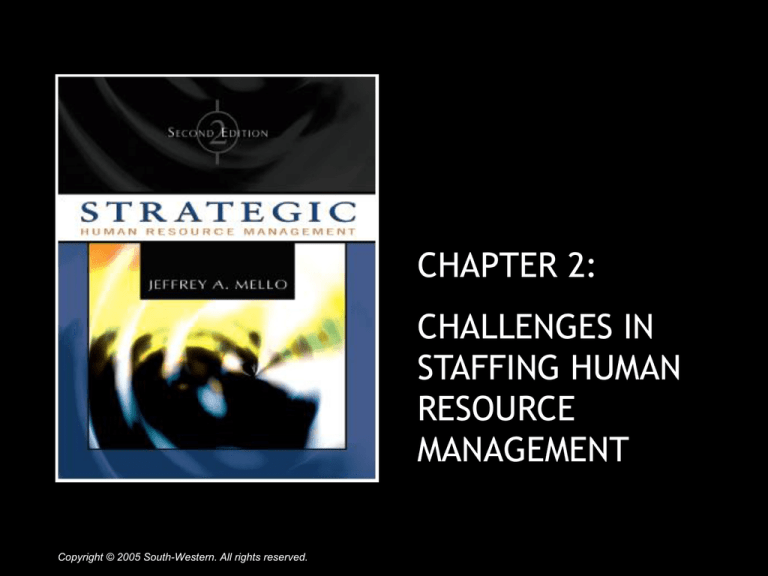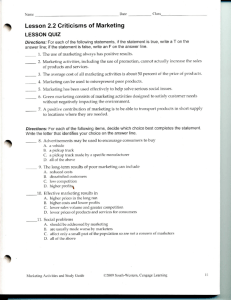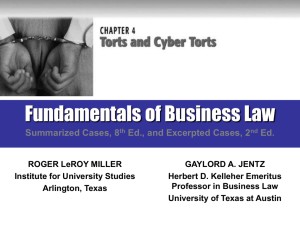
CHAPTER 2:
CHALLENGES IN
STAFFING HUMAN
RESOURCE
MANAGEMENT
Copyright © 2005 South-Western. All rights reserved.
Major Factors Affecting HRM
Technological
Advancement
Demographics
and Diversity
Strategic
HRM
Globalization
Copyright © 2005 South-Western. All rights reserved.
1–2
Exhibit 2-1
Issues for Integrating New Technologies
Copyright © 2005 South-Western. All rights reserved.
1–3
Exhibit 2-2
Impact of Technology on Organizations
Copyright © 2005 South-Western. All rights reserved.
1–4
Technology Challenges for HRM
• Telecommuting
• Employee surveillance & monitoring
• e-HR
• Ethical behavior
Copyright © 2005 South-Western. All rights reserved.
1–5
Telecommuting
• Dramatic growth in
number of Americans
working from home
– 3.4 million in 1990
– 19.6 million by beginning
of 2000
Copyright © 2005 South-Western. All rights reserved.
• Issues affecting success of
telecommuting programs
– Clear performance
measurement system is key
– Deciding which employees
will be offered participation
– Equipment expense
– Some managers
uncomfortable having
direct reports away from
office
1–6
Employee Surveillance and Monitoring
• More than 80% of large employers utilize
monitoring technology
–
–
–
–
–
Internet usage
E-mails
Computer files
Voice-mail
Telephone usage
• Under Electronic Communications Privacy Act
(ECPA) employees have only limited privacy
rights
Copyright © 2005 South-Western. All rights reserved.
1–7
E-HR
• Opportunity to deliver transactional types
of services online
–
–
–
–
–
–
Payroll
Employee benefits
Scheduling
Recruiting
Training
Career development
Copyright © 2005 South-Western. All rights reserved.
1–8
Ethical Behavior
• Majority of jobs are
considered to be “atwill”
• Movement toward
greater protection for
employees in regard to
off-duty behavior
• Ownership of work
• Fairness of
noncompete clauses
Copyright © 2005 South-Western. All rights reserved.
• Sarbanes-Oxley Act of
2002
– Eliminates deception in
accounting &
management practices
by increasing
government oversight
– Holds senior executives
more directly responsible
for violations
– Protects “whistleblowers”
1–9
Workforce Demographic Changes:
“Graying” of Workforce
• Negative aspects of
older workers
– Perceived resistance to
change by older
workers.
– Increased health-care
costs for senior workers
– Blocking advancement
opportunities for younger
workers
– Higher wage & salary
costs for senior workers
Copyright © 2005 South-Western. All rights reserved.
• Positive aspects of
older workers
– As productive or more
productive than younger
workers
– Have more
organizational loyalty
than younger workers
– Possess broader
industry knowledge &
professional networks
1–10
Workforce Demographic Changes
• Baby Boomers (1945–1962)
– In excess supply in middle management ranks
– HR challenge is to manage “plateaued” workers
• Baby Busters (1963–mid-1970s)
– Are career bottlenecked by Boomers
– Who have skills in high demand are doing & will do
well
Copyright © 2005 South-Western. All rights reserved.
1–11
Workforce Demographic Changes
• Generation “X”ers (late 1970s–early 1980s)
– Have life-long exposure to technology & constant change
– Seek self-control, independence, personal growth, creativity
– Not focused on job security or long-term employment
• Generation “Y”: “Baby Boom Echo” (after 1979)
–
–
–
–
–
High comfort level with technology
Global & tolerant outlook on life
Highly entrepreneurial
Shorter attention span
Opting for more transient & variable project work
Copyright © 2005 South-Western. All rights reserved.
1–12
Workforce Demographic Changes
• Sexual orientation
– More than 200 Fortune 500 employers offer full benefits for
domestic partners
– Sexual orientation issues can impact bottom line
• Disabilities
– 54 million Americans with disabilities
– Often not included in diversity initiatives
– Many supervisors do not understand needs of employees
with disabilities
– Stereotypes
Copyright © 2005 South-Western. All rights reserved.
1–13
New Employee/Workplace Dynamics
• Emphasis on management of professionals
– Establishment of separate career tracks
• Technical/Professional, Managerial /Administrative
– Use of project teams
• Less employee loyalty, more loyal to self
– Staying with employers for shorter periods;
demanding more meaningful work & involvement in
organizational decisions
Copyright © 2005 South-Western. All rights reserved.
1–14
New Employee/Workplace Dynamics
• Increased personal & family dynamic
effects
– More single-parent families, dual-career couples, &
domestic partners
• Increased nontraditional work relationships
– Part-time, consulting, & temporary employment
flexibility
– Outsourcing & entrepreneurial opportunities
Copyright © 2005 South-Western. All rights reserved.
1–15
Ethnicity
• By 2050
– Close to 50% of US
population will be
non-Caucasian
• By 2005
– Ethnic minority
share of workforce
will be 28%
– Up from 22% in
1990 & 18% in
1980
Copyright © 2005 South-Western. All rights reserved.
• By 2025
– African-Americans will
represent 14% of population
– Up from 12% in 1994
– Hispanics will represent 17%
of population
– Up from 10% in 1994
– Asians & Pacific Islanders
will represent 8% of
population
– More than double from 1994
1–16
Managing Workplace Diversity
• Understanding &
appreciating diversity
– Critical to effectively
marketing to ethnic & minority
groups
– Promoted by having diverse
workforce at all levels
– Helps ensure hiring &
promotion decisions are
unbiased by person
differences
Copyright © 2005 South-Western. All rights reserved.
• Diversity management
programs or initiatives
– Must be integrated with
organization’s mission &
objectives
– Help key decision makers
identify diversity’s benefits to
organization
– Make critical decisions about
implementing optimal
program/initiative contingent
on organization & its people,
mission & culture.
1–17
Exhibit 2-6
Individual Dimensions of Diversity
Copyright © 2005 South-Western. All rights reserved.
1–18
Strategic Management of Diversity
• Determine why diversity is important
• Articulate how diversity relates to mission & strategic
objectives
• Define diversity & determine how inclusive its efforts will
be
• Make a decision as to whether special efforts should be
extended to attract diverse workforce
• Assess how existing employees, customers, & other
constituencies feel about diversity
• Determine specific types of diversity initiatives that will
be undertaken
Copyright © 2005 South-Western. All rights reserved.
1–19
Reading 2.1
Five Challenges to Virtual Team Success
• Virtual teams:
– Groups of people who work interdependently with shared
purpose across space, time, & organization boundaries
using technology to communicate & collaborate
• Types of virtual teams
– Global virtual teams
– Teams assigned to accomplish specific projects
– Cross-functional teams
• Challenge: Recognize obstacles confronting teams
that are both cross-functional & virtual
Copyright © 2005 South-Western. All rights reserved.
1–20
Reading 2.1
Five Challenges to Virtual Team Success
• Building trust within virtual teams
• Maximizing process gains & minimizing process
losses on virtual teams
• Overcoming feelings of isolation & detachment
associated with virtual teamwork
• Balancing technical & interpersonal skills among
virtual team members
• Assessment & recognition of virtual team
performance
Copyright © 2005 South-Western. All rights reserved.
1–21
Reading 2.2
Impact of the Sarbanes-Oxley Act
• New whistleblower protections
– No public company may discriminate against
employee because of any lawful act
– Retaliation against employee because of any lawful
act done to assist a proceeding relating to alleged
violation is prohibited
– If DOL determines that violation has occurred,
employer may be ordered to reinstate employee &
provide compensatory damages
Copyright © 2005 South-Western. All rights reserved.
1–22
Reading 2.2
Impact of the Sarbanes-Oxley Act
• The Act dramatically affects officer compensation
programs
– Executive bonuses subject to forfeiture under Act
– Personal loans to executives are regulated by Act
– SEC can remove or temporarily freeze payments to
executives & directors
– Public accounting firms are precluded from auditing
company if highly placed executive was employed by
auditing firm & participated in company’s prior year’s audit
– Attorneys have new rules of professional responsibility
Copyright © 2005 South-Western. All rights reserved.
1–23
Reading 2.2
Impact of the Sarbanes-Oxley Act
• The Act requires new employment policies &
procedures
– Procedures for receiving & handling complaints of corporate
fraud have to be established
– Compensation program bonus policies & stock option plans
have to take account of new forfeiture provisions
– Hiring & recruitment strategies & background checks will
have to be revamped to avoid hiring executives whose
employment is precluded by the Act
– Training required to properly implement all Act’s mandates
Copyright © 2005 South-Western. All rights reserved.
1–24
Reading 2.3
Employee Satisfaction
• Potential impact of
demographic changes
– Aging population increases
emphasis on health care
benefits, retirement planning,
& job security
– Women are attaining higher
proportion of professional
qualifications
– Future skills shortages may
cause industrialized countries
to compete for skilled
immigrant labor
Copyright © 2005 South-Western. All rights reserved.
• Industrial base shifting to
service & health care
sectors
• Wider political &
economic trends affecting
job satisfaction
– Health care costs
– Job security
– Pensions
1–25
Reading 2.3
Employee Satisfaction
• Two groups of issues
– Those depending on financial position of
company
• Benefits
• Wages
• Job security
– Those less costly to implement through changing
practices, processes, & culture
•
•
•
•
Communication with management
Work/life balance
Employee’s relationship with immediate supervisor
Career development
Copyright © 2005 South-Western. All rights reserved.
1–26






